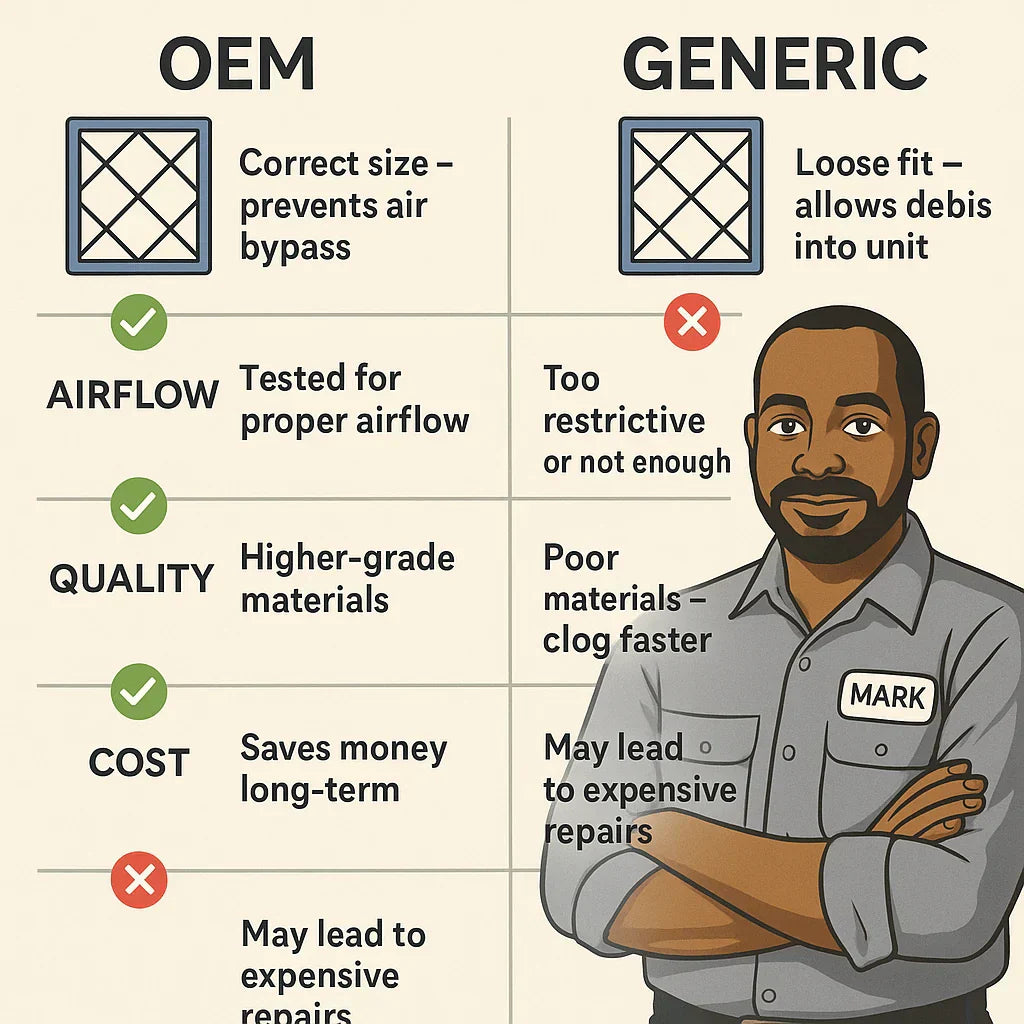📖 Introduction: Why This Question Matters
When I’m on-site at hotels, apartments, or even residential jobs, I get the same question all the time:
👉 “Do I really need to buy OEM PTAC filters, or can I save money with a generic?”
At first glance, a filter looks simple — just some mesh or fiber inside a frame. But after 15+ years in the field, I’ve seen first-hand how much difference the right filter makes.
Hotpoint PTAC Replacement Filters (Pair of 2)
Filters are not just about trapping dust — they’re about maintaining airflow, protecting your coils, and keeping your PTAC unit running for its full lifespan. Using the wrong filter might save a few bucks at checkout, but it can cost hundreds — even thousands — down the line.
In this guide, I’ll break down:
-
The differences between OEM and generic PTAC filters
-
The problems generics can cause (airflow, fit, efficiency, warranties)
-
When generics might be okay — and when they’ll burn you
-
My installer’s recommendation for hotels, property managers, and homeowners
🛠️ What OEM PTAC Filters Are Designed For
OEM (Original Equipment Manufacturer) filters are built specifically for your PTAC brand and model — like GE Hotpoint PTAC replacement filters. They’re not just cut to size; they’re engineered for your system’s performance needs.
Key Advantages of OEM Filters
-
🎯 Perfect Fit — Designed to slide in snugly with no gaps, preventing air bypass.
-
🌬️ Optimized Airflow — Balanced to block dust without over-restricting airflow.
-
🧪 Performance Tested — Meets the manufacturer’s specifications for dust capture and energy efficiency.
-
🛡️ Warranty Protection — Many manufacturers specify OEM filters to avoid voiding coverage.
💡 Mark’s Pro Tip: I’ve seen PTACs last 12+ years with consistent OEM filter use — and I’ve seen the same models die in 5 years when fitted with poor-quality generics.
🛑 Common Issues with Generic Filters
On paper, a generic filter looks like a good deal. But in the field, here’s what I actually see happen:
1. ⚠️ Loose Fit = Air Bypass
If the filter doesn’t fit snugly, air (and dust) slips around the edges. That dust coats your evaporator coil, clogs fins, and breeds mold.
2. ⚡ Too Restrictive = Blower Strain
Some off-brand filters are denser than OEM designs. That chokes airflow, forcing the blower motor and compressor to work harder. More energy use, more wear, and higher bills.
3. 🗑️ Lower Material Quality
I’ve seen generics collapse or warp after just a few weeks. That means you’re replacing them more often, which cancels out any savings.
4. 🚫 Warranty Risk
If your PTAC is under manufacturer warranty, using non-OEM filters may void coverage for airflow-related failures (like compressor burnout).
⚡ Performance Impact: What’s Really at Stake
Dirty or poorly fitted filters hit your PTAC system in multiple ways:
-
🔄 Reduced Airflow — Less conditioned air reaching the room.
-
❄️ Coil Freezing — Restricted flow leads to ice buildup.
-
🔥 Overheating — Motors and compressors strain under load.
-
📈 Higher Energy Bills — System works longer to reach set temperatures.
-
⏳ Shorter Lifespan — A PTAC designed for 10–12 years may only last 5–7.
💡 Mark’s Pro Tip: Always weigh the lifetime operating cost — not just the sticker price of the filter.
💵 The Cost Question: $10 Saved vs. $1000 Spent
Let’s put numbers on it.
-
A pair of OEM GE Hotpoint filters costs around $15–$20.
-
A generic pair might cost $10–$15.
-
That’s a $5–$10 difference per replacement cycle.
Now compare that to the costs I’ve seen from generic-related failures:
-
💸 Coil cleaning: $200–$400
-
💸 Blower motor replacement: $300–$500
-
💸 Compressor failure: $800–$1200
-
💸 Full PTAC replacement: $700–$1500
So ask yourself: would you rather save $10 now, or spend $1000 later?
✅ When Generics Might Be Acceptable
I’ll be honest — there are a few limited cases where a generic might make sense:
-
Low-use PTACs: Guest rooms or vacation rentals used only a few times a year.
-
Emergency stopgap: When you need a filter now and OEM stock isn’t available.
-
Budget pinch: If you’re managing a property and just need a temporary fix until OEM shipments arrive.
But even in these cases, I recommend swapping back to OEM as soon as possible.
💡 Mark’s Pro Tip: If you must use a generic, make sure it’s the exact dimensions and not overly restrictive. Always test airflow after installation.
🏨 Why Hotels and Property Managers Should Always Stick with OEM
For hotels and rental properties, filters aren’t just about equipment — they’re about guest satisfaction and reputation.
-
Guests notice musty odors and weak airflow.
-
Poorly filtered air can trigger allergy complaints.
-
High utility costs eat into operating margins.
-
Frequent PTAC failures mean rooms offline = lost revenue.
OEM filters are a small investment for a big payoff in reliability, comfort, and cost control.
📝 Mark’s Final Word
Here’s the bottom line from someone who installs and maintains PTACs for a living:
👉 Generic filters may look the same, but they don’t perform the same.
They can restrict airflow, let dust bypass, and void warranties. Sure, you’ll save a few bucks upfront — but you’ll pay for it later in higher bills, expensive repairs, and shorter unit lifespans.
If you’re serious about protecting your PTACs (and your wallet), stick with OEM filters like GE Hotpoint. They’re designed for the job, they fit right every time, and they keep your system running like new.
Spend a little now, save a lot later. That’s the smart move.
In the next topic we will know more about: Mark highlights the warning signs Your PTAC Filter Needs Immediate Replacement







